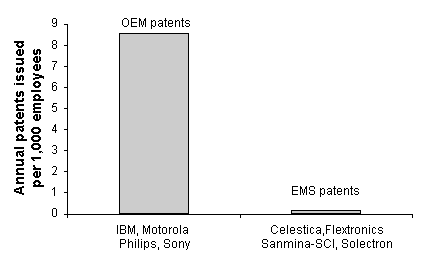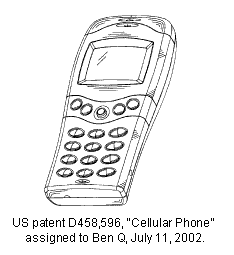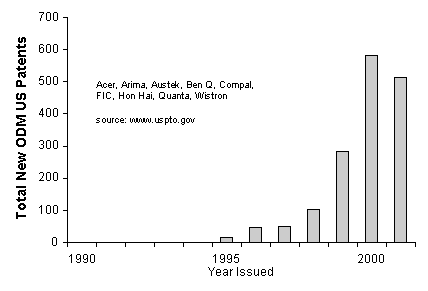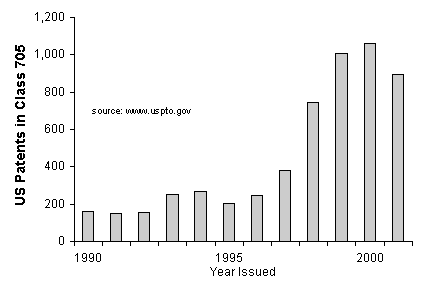

Obtaining Value from EMS PatentsBy Mark Nowotarski EMS providers can obtain considerable value from well-managed patent portfolios. Patents are becoming a major priority for electronics manufacturing services (EMS) companies. The recent success of patent-intensive original design manufacturer (ODM) companies, combined with the new opportunities of "business method" patents, will increase the strategic and monetary value of patents for EMS providers. To obtain value from patents, EMS companies are currently taking three critical steps:
Most EMS patent portfolios are small when compared to their original equipment manufacturer (OEM) counterparts (Figure 1). The actual patents are often viewed as an impediment to the basic EMS way of doing business. 
FIGURE 1: Relative patent activity of OEM and EMS companies. As Jim Sacherman, chief marketing officer of Flextronics, recently affirmed, "We don't own intellectual property."1 The ODM Challenge 
FIGURE 2: Patented white box cell phone. ODM patent activity has skyrocketed in the past five years (Figure 3). Major players, like Hon Hai, are now producing patents at a rate that rivals that of OEM patent powerhouses such as IBM. ODMs appear to be viewing patents as a manufactured product and are ramping up production accordingly.2 
FIGURE 3: ODM patents skyrocket. In response to ODM successes, EMS companies are now incorporating product design into their offerings. This design activity will mean a substantial increase in patent activity. Those EMS providers that embrace patents will find that new opportunities arise for them not only in protecting intellectual property, but also in expanding business in new and substantial ways. The Business Method Opportunity The business method patent is a patent on a new and useful way to run a business. The number of business method patents has increased dramatically in the past few years (Figure 4), driven by the emergence of widespread interconnected computer networks (the Internet) that have enabled the automation of many distributed business operations. The rising numbers are also driven by the unambiguous 1998 decision by the U.S. Court of Appeals for the Federal Circuit (later upheld by the U.S. Supreme Court) that ruled that a pure algorithm, even for a new method of doing business, is patentable provided it is "applied in a 'useful' way."3 
FIGURE 4: Business method patents surge. Today, business method patents exist in virtually every aspect of business management, meaning inventors are now found in every part of an organization, not just in research and development (R&D). Information technology (IT) departments, in particular, are producing more patents than ever before. Business method patents can also provide a significant licensing opportunity. Best practices may be licensed to adjacent industries facing similar problems. For example, software improvement may be licensed back to software providers, and direct competitors may be prevented from unauthorized duplication of improved systems. Semiconductor foundries, such as Taiwan Semiconductor, are already developing substantial business method patent portfolios. The areas of "resource allocation" and "plant scheduling" are particularly active.4 Solectron appears to be the first major EMS provider to patent business methods. The company was recently awarded a suite of four patents5 issued on an improved e-mail routing system. The specific application of this invention is "engineering change notification." The patents are broadly written, however, and cover a variety of processes related to the handoff of e-mails in a chain of command. Vince DePalma, vice president of technology and new product development at Solectron, stated, "These patents are a beginning for us. We have a major effort in both internal and external communications technology. We want to make sure we maintain our leadership in this area." A Successful Case History Sanmina-SCI evaluates the licensing strategy for different technologies on a case-by-case basis. One strategy the company finds successful is to broadly license a technology under terms that maximize revenue—without impeding the adoption of the technology. The license package may include extensive technical support in addition to rights to practice the patents. Technology support materials and training may be routinely updated and access may be given to improvements in a particular technology as they are developed and proven. Basic patent training is provided to engineers, business managers and customers. Educating all involved in the process is an important part of the program. In particular, education programs have helped the company develop licensees in China, where patents and other basic concepts of intellectual property law are relatively new. R&D engineers receive additional training on how to write effective invention disclosures—reports that patent attorneys and patent agents use to prepare formal applications submitted to the patent office. The applications include a description of the invention, the history of when each aspect of the invention was conceived, the names of those who contributed to the invention and other factual data required by the patent office. A well-written invention disclosure can substantially reduce patent application preparation fees. U.S. patent applications can cost $7,000 to $20,000 to prepare and submit, depending upon the complexity of the invention. Such costs can be cut by up to 50 percent with well-written invention disclosures. Competitive patent tracking at Sanmina-SCI is performed using government online databases (U.S. Patent Office, http://www.uspto.gov/) and commercial databases (Micropatent, http://www.uspto.gov/). When a patent of interest is discovered, the application is routed to the appropriate technical, business and legal staff for comment. The significance of the patent is then assessed, and the appropriate action is taken. Conclusion Sustaining a well-managed patent portfolio allows EMS companies to protect innovations from copying, to grow income from licensing revenue and to increase their overall market through controlled dissemination of improved technologies. The critical steps to obtaining value from patents are: 1) strategic planning to incorporate patents into the company's business model; 2) the education of employees and 3) continuous monitoring of competitive patent activities. References
 
Copyright © 2002 - UP Media Group | Markets, Patents & Alliances30 Old Kings Highway, South Suite 135 Darien, CT 06820 PH: 203.975.7678 FX: 203.973.0010 FREE CONSULTATIONHave a
|